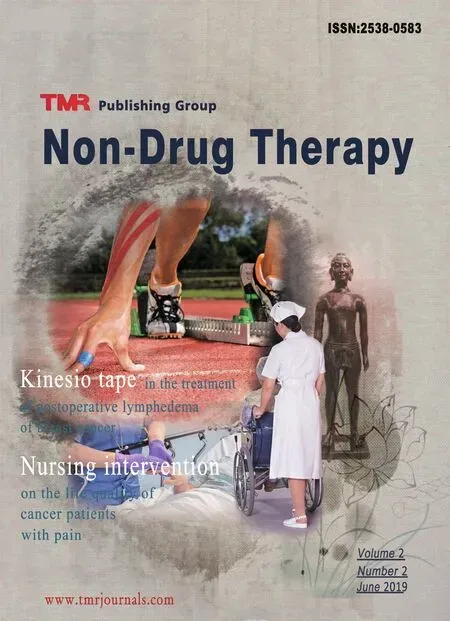Kinesio tape in the treatment of postoperative lymphedema of breast cancer
2019-06-28FuYuLengZhuYangFengXiLongLiLuoWenYuWuDongXinTang
Fu-Yu Leng, Zhu Yang, Feng-Xi Long, Li Luo, Wen-Yu Wu, Dong-Xin Tang, *
Kinesio tape in the treatment of postoperative lymphedema of breast cancer
Fu-Yu Leng1, Zhu Yang1, Feng-Xi Long1, Li Luo2, Wen-Yu Wu3, Dong-Xin Tang3, *
1Guiyang College of Traditional Chinese Medicine, Guiyang, 550001, China.2Guihang Guiyang Hospital, Guiyang, 550001, China.3First Affiliated Hospital of Guiyang College of Traditional Chinese Medicine (Tumor Inheritance and Scientific and Technological Innovation Talents Base of Traditional Chinese Medicine in Guizhou Province), Guiyang, 550001, China.
The Kinesio tape, originally developed by Dr. Kenzo Kase, a Japanese chiropractor, was used for pain of joint and muscle. The elastic tape is capable of stretching up to 130-140% of its resting static length ensuring free mobility of the applied muscle or joint. It is claimed that Kinesio tape supports injured muscles and joints and helps relieve pain by lifting the skin and allowing improved blood and lymph flow. Therefore, Kinesio Taping has become a very popular treatment for several health conditions over the last decade. Nowadays, lymphatic drainage is a new function of Kinesio taping in the field of physical therapy. This article explores the application of Kinesio tape in breast cancer-related lymphedema in order to provide a new treatment for patients with lymphedema after breast cancer surgery.
Kinesio tape, Breast cancer, Lymphedema, Physical therapy.
Kinesio tape has the advantages of convenient use, short operation time without affecting the mobility of limb, long curative effects and less side-effects and good patient's compliance. It is a new treatment for patients with lymphedema after breast cancer surgery.
This paper analyzes the effects of Kinesio tape on breast cancer postoperative lymphedema, which will provide evidences for its clinical effects on lymphedema limbs. Kinesio tape has the advantages of short cure period, no pain, not easy to be repeated, economical, convenient and easy to operate, without any effects on limbs mobility. Kinesio taping has become a very popular treatment for several health conditions over the last decade. However, when choosing intramuscular patch to treat lymphedema after breast cancer surgery, strict screening should be carried out to prevent adverse effects caused by inferior products from aggravating diseases.
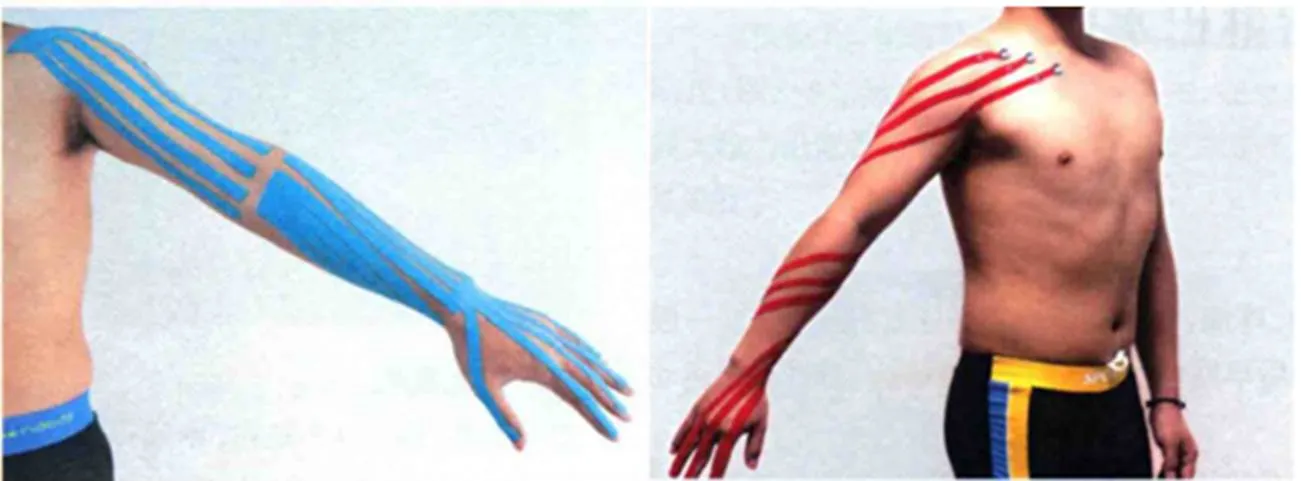
The authors declare that there is no conflict of interests regarding the publication of this paper.
Chang Liu
Introduction
Breast cancer is a disease with the highest morbidity and mortality in woman’s malignant tumors. Surgery is the primary treatment for breast cancer; however, it will inevitably cause damage to muscle tissue, lymphatic vessels and blood vessels. Breast cancer-related lymphedema is a common complication resulted from surgery. Postoperative radiotherapy will further aggravate the lymphatics damage [1]. Breast cancer-related lymphedema may have a physical, psychological, and functional impact, and it increases the risk of repeated episodes of superficial infection. It is worth placing importance on the intervention of secondary lymphedema. Decongestive lymphatic therapy is common management for lymphedema. The currently methods include manual lymphatic drainage, exercise therapy, low-stretch elastic bandage dressing, and symptomatic skin nursing [2]. The Kinesio tape has the advantages of short cure period, no pain, not easy to be repeated, economical, convenient and easy to operate, without any effects on limbs mobility. This paper analyzes the effects of Kinesio tape on breast cancer postoperative lymphedema, which will provide evidences for its clinical effects on lymphedema limbs.
Overview of Kinesio tape [3]
The constitute of Kinesio tape
The Kinesio tape is a kind of elastic adhesive tape with a stretch of 140% to 160% to its static length(Figure 1). It has structure with different three stories to make up: the first layer consists mainly of cotton cloth with similar skin thickness, whose special weaving method ensures its air permeability and longitudinal ductility; the second layer is composed of medical acrylic layer, which is mainly related with its elasticity and adhesion and partly with its air permeability; the third layer is composed of release paper, which is easy to separate and paste the protective gel; this layer also insulates the gel from contamination and prevents skin damage. Kinesio tape does not contain any drugs or hormones, it is safe for most people. But the cottons cloth and gel may cause allergic actions.
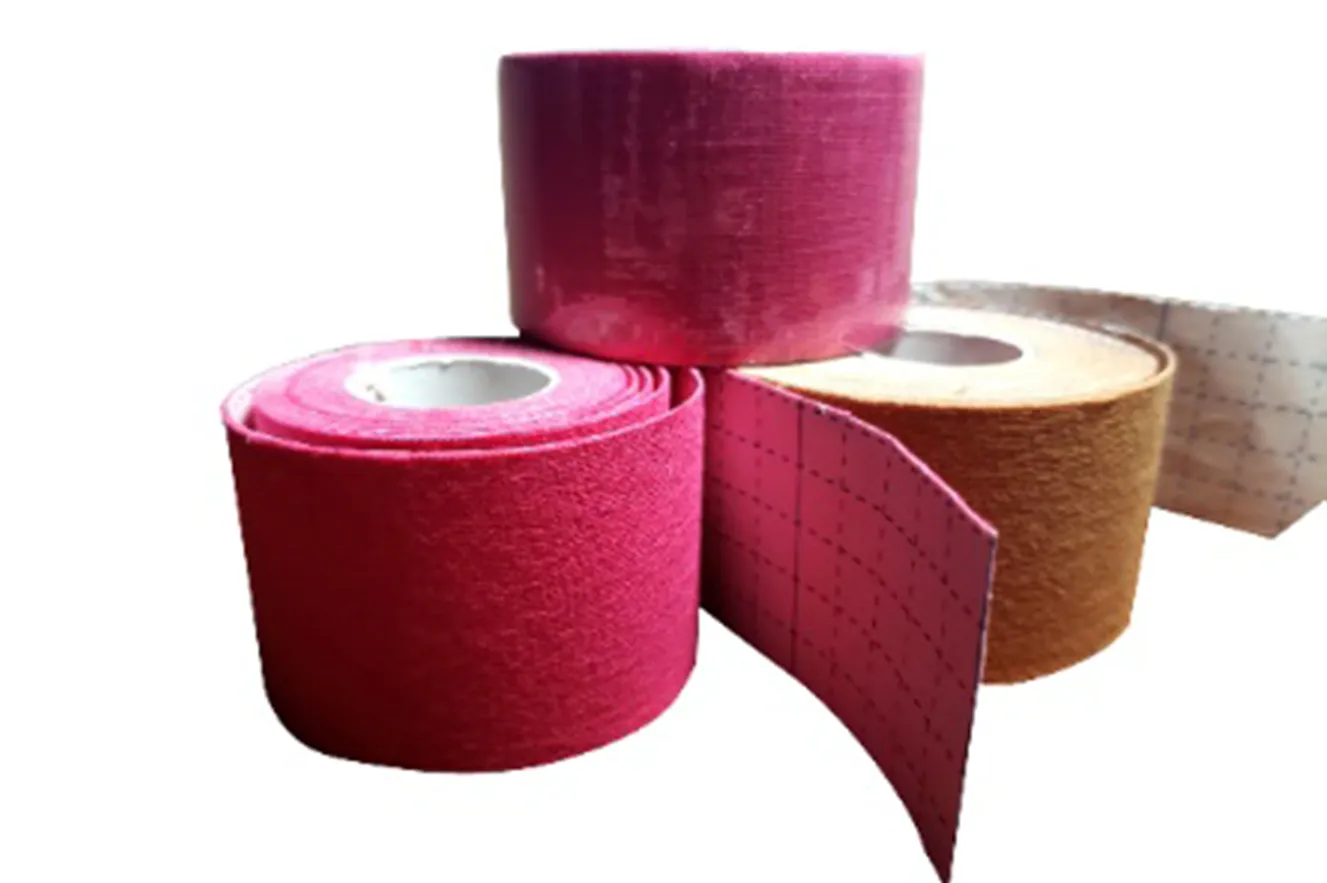
Figure 1 Kinesio tape
Technical terms
There are some technical terms for Kinesio tape in clinical use. For example, (1) positioning: it mainly refers to the active and passive positioning of the corresponding limb where the binding area is stretched or shortened. (2) Anchor: refers to the first fixed end of the tie, generally do not apply tension. (3) Substrate and tail end: the substrate mainly refers to the sticking part that continues to the anchor, and the tail end mainly refers to a part of sticking cloth reserved at the distal end of the substrate (this part generally does not exert pulling force). (4) Extension direction: refers to the direction from the anchor end to the tail end. (5) Retraction direction: refers to the direction in which the tail end retracts to the anchor end, usually the back binding part retracts to the first binding part and the small mass part retracts to the large mass part. (6) Tensile force: it is mainly converted by its absolute tensile length (i.e. tensile length/original length × 100%) or relative tensile length (i.e. tensile length/maximum tensile length × 100%). In theory, 0-20% of the absolute length is used for lymph patch, while the anchor end and tail end generally use natural pulling force. The wrinkles produced after sticking are considered to be one of the important mechanisms of action.
Taping technique
Tape cutting shapes include I-shaped, Y-shaped, claw-shaped, X-shaped, O-shaped, square and other shapes. For patients with lymphedema, the anchor end is usually fixed to the proximal end in a claw shape and extended to the tail end, which is commonly used for regional lymph node drainage. For lymph-vessel damage, the tape should be cut into an I-shaped then helically twined in the arm.
Duration for taping
After a long time, the elasticity of the tape will be affected and the treatment effect will be low. Generally, the tape can last for 1-3 days and the longest time can last for 5 days, which can be adjusted according to the specific situation. However, for lymphedema treatment, after 3 days’ taping, a new tape should be conducted at intervals of 1 day to ensure the therapeutic effect.
Impact factors
Different brands of Kinesio tape have different elasticity. The external environment (such as humidity, temperature) will also have a certain impact on the tape. Generally speaking, the humidity in 30%-40% is the most ideal environment, and if the humidity is more than 50%, the effects will be influenced. If the temperature is too high, the tape will get soften, while when it is too low, it tends to harden.
Mechanism of Kinesio tape for lymphedema
Kinesio tape and lymphatic reflux mechanism [3-4]
The lymphatic system mainly consists of lymphatic vessels, lymph nodes, spleen and thymus. Lymphatic vessels can be divided into superficial lymphatics and deep lymphatics according to their location. Superficial lymphatics mainly collect lymph from skin and subcutaneous tissues. Deep lymphatics mainly collect lymph from muscles, viscera and other parts. All lymph finally flows into veins through the left thoracic duct and the right lymphatics for circulation. Lymphatic fluid is mainly collected from the tissue through capillary lymphatic vessels. The one-way flap of the lymphatics prevents the lymph from flowing back and promotes the return of the lymph to the heart. The main driving force for lymphatic drainage is the pressure difference between the tissue fluid in the tissue and the lymph in the capillary lymphatic vessels. Kinesio tape is stuck on the skin surface, which can increase the tension of subcutaneous connective tissue. At the same time, a pressure difference will be generated between the taping area and adjacent tissues, and the liquid will flow rapidly along the pressure difference to the direction of lymph backflow under the retraction force of Kinesio tape. The release effect of Kinesio tape on subcutaneous space can create a better "circulation environment", which can further relief swelling symptoms by accelerating lymph and blood reflux, alleviating inflammatory reaction and promoting self-repair ability of damaged organism (Figure 2) [5-6]. Researches also showed that after taping, the thickness of subcutaneous tissue increased and it is greater than the diameter of arterioles and micro vessels in microcirculation of human body, thus it can indirectly prove that Kinesio tape has the function of improving circulation.
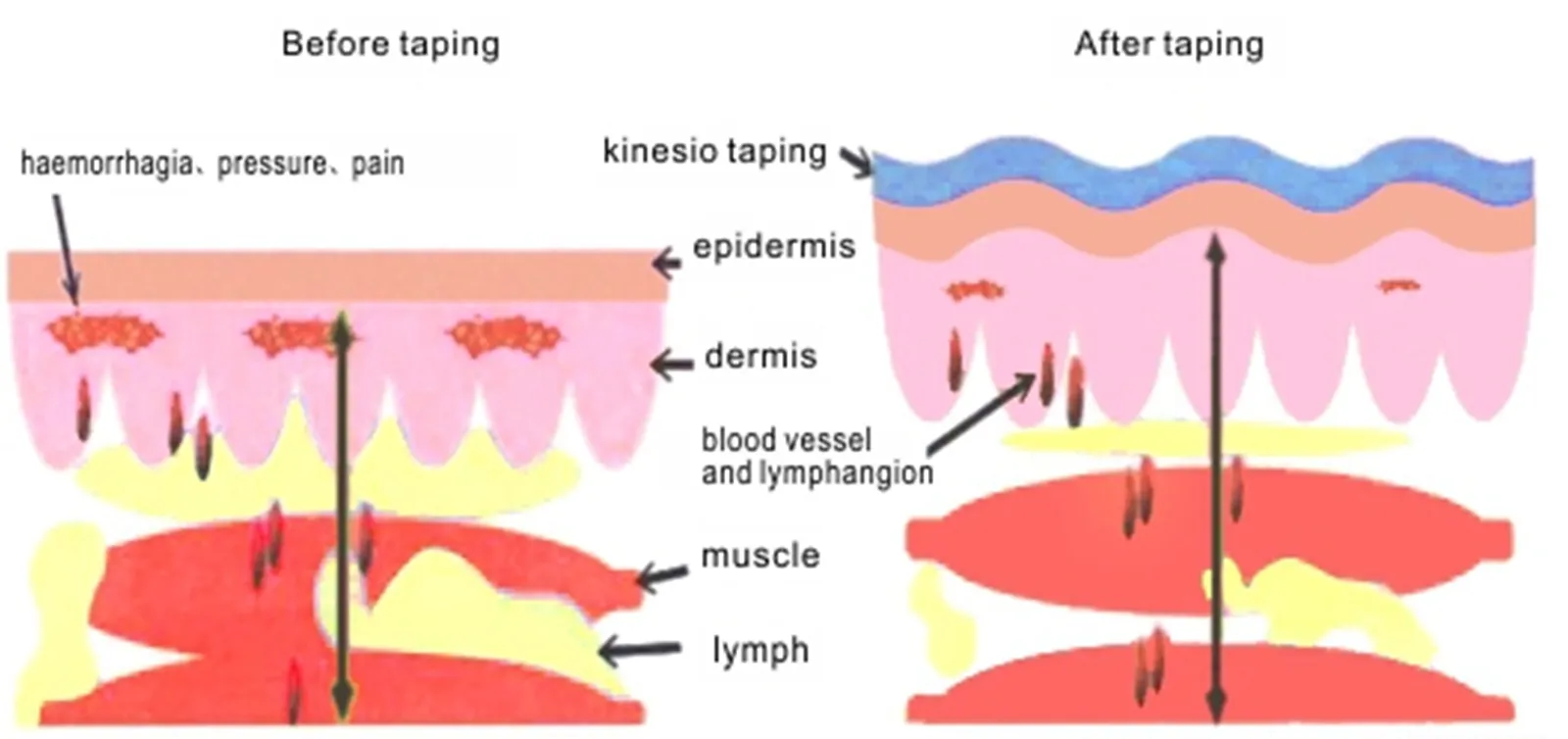
Figure 2 The effects of Kinesio tape
Taping technique for lymphedema [3]
For patients with complete lymph vessel, drainage is carried out step by step, which is mainly divided into upper arm volar side, forearm volar side, upper arm dorsolateral side, forearm dorsolateral side and dorsal palmar side lymph drainage binding (Figure 3). Claw-shaped tape is usually used. Drainage at the palmar side of the upper arm, the anchor of tape mainly fixes at the subacroclavicular acromion end and extends to the elbow joint with natural tension. Drainage on the volar side of the forearm mainly, the anchor of tape fixes on the medial side of the elbow joint, and the natural tension extends to the wrist joint. The back side of the upper arm the anchor of tape fixes at the back of the shoulder joint and extends to the lateral elbow with natural tension. The dorsal forearm the anchor of tape fixes above the lateral condyle of humerus, and the natural tension extends to the dorsal metacarpal joint. In the dorsal metacarpal drainage, the anchor of tape fixes on the dorsal metacarpal joint and extends it to the end of the five finger knuckles respectively with natural pulling force.
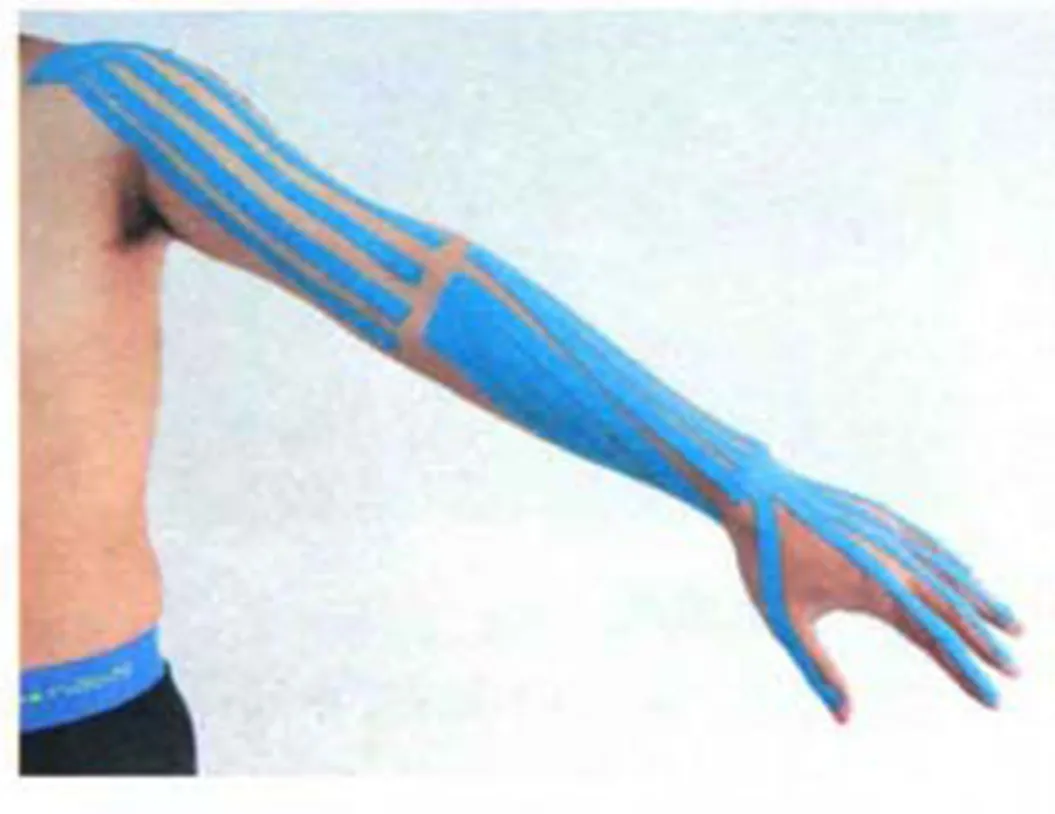
Figure 3 The method of Kinesio tape for patients with complete lymph vessel
For patients with lymphatic channel damage, I-shaped taping is often used. Four I-shaped patches with a width of about 1.25 cm can be cut respectively, and the anchor is fixed in the area between the shoulder and the lower part of the collarbone, which encircles the whole affected limb 4-5 times in a spiral way, with the tail end extending to the end of the finger joint (Figure 4). Attention should also be paid to the positioning of the patient and the pulling force used in the sticking (calculated by absolute pulling force, theoretically 0-20 % pulling force can be used for lymphatic sticking). Wrinkles after taping are considered to be one of the main mechanisms, and related studies show that the retraction force of the tape is related to the external pulling force, shape and length [5]. Therefore, different degrees of pulling force can be applied clinically according to the specific conditions of patients.
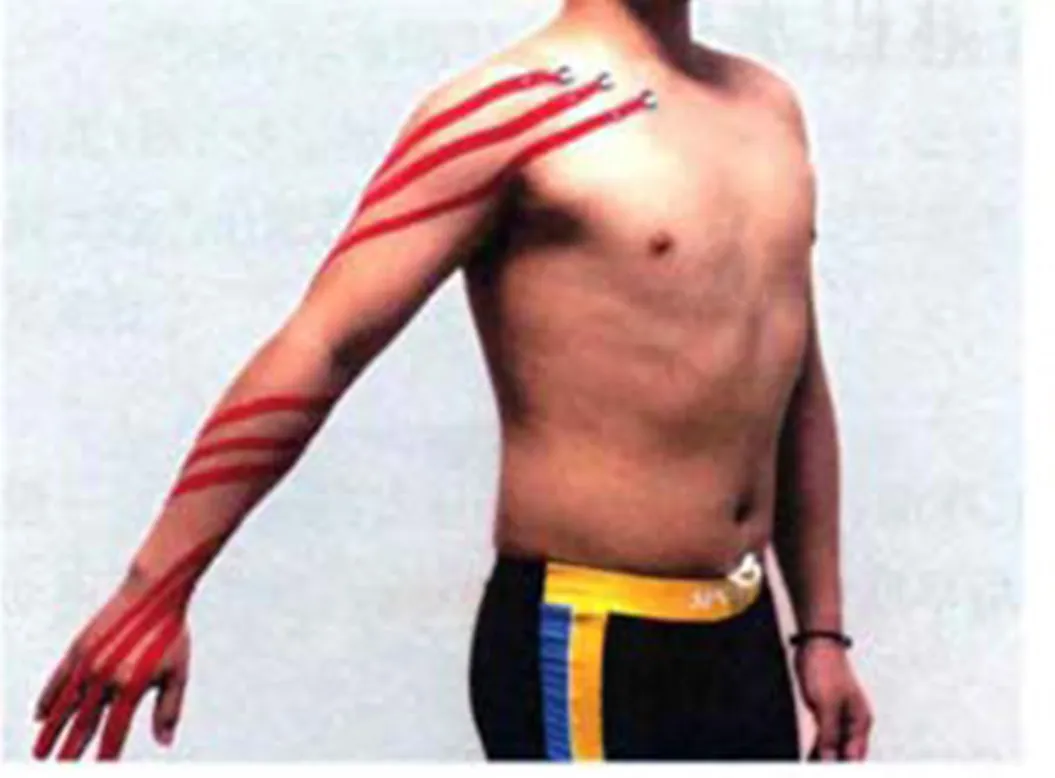
Figure 4 The method of Kinesio tape for patients with lymphatic channel damage
Application of Kinesio tape in lymphedema after breast cancer surgery
Kinesio tape has gradually developed in the field of medicine, and has also shown prominent curative effects in the treatment of lymphedema. Postoperative edema of breast cancer is related to the number of lymph nodes cleaned, radiotherapy, age and body mass index. There is some researches show that, in the short term, the effect of Kinesio tape on improving lymphedema after breast cancer surgery is equivalent to the winding effect of multi-layer bandages, but its waterproof, air permeability and convenience make it easier for patients to accept [7]. A meta-analysis of the efficacy and safety of Kinesio tape in the treatment of cancer-related lymphedema shows that Kinesio tape are significantly better than bandages in improving the symptoms of lymphedema, and patients are more likely to choose Kinesio tape in hot weather, but the study also shows that the comfort brought by Kinesio tape is not better than bandages [8]. Domestic research shows that in terms of improving lymphedema after breast cancer surgery, Kinesio tape is obviously better than traditional rehabilitation training [9]. The study included 80 patients who met the inclusion criteria and were randomly divided into a treatment group and a control group. The treatment group was treated with Kinesio tape, while the control group was treated with rehabilitation training. All patients were evaluated after 4 weeks of treatment and were followed up for 3 months after treatment. The results showed that the difference between the Kinesio tape group and the rehabilitation training group (t = 2.218,= 0.029) was statistically significant, and the efficacy of the Kinesio tape was better than that of the traditional rehabilitation training. The results of follow-up for 3 months showed that there was no obvious change in the volume of Kinesio tape group (t = 0.223,= 0.824). It shows the durability of the effect of Kinesio tape. In another study, the experimental group was treated with Kinesio tape combined with common rehabilitation therapy, while the control group was treated with Kinesio tape ineffective plaster combined with common rehabilitation therapy [10]. The Kinesio tape group was treated with claw-shaped combined with I-shaped tape for 48 hours, with 7 times as a course of treatment, and the interval of each patch was 1 day. Ordinary manipulative rehabilitation therapy refers to 3-week intervention by a rehabilitation technician, including massage from the distal end of the hand to the proximal end, elevation of affected limb, air pressure therapy,The results showed that the experimental group had 12 cases of mild edema, 19 cases of moderate edema, 3 cases of severe edema, 29 cases of mild edema, 5 cases of moderate edema and 0 cases of severe edema before treatment; the control group had 13 cases of mild edema, 16 cases of moderate edema, 5 cases of severe edema, 19 cases of mild edema, 15 cases of moderate edema and 0 cases of severe edema before treatment. The improvement of edema in the experimental group was better than that in the control group (< 0.05), and Kinesio tape was better than conventional rehabilitation techniques in treating upper limb lymphedema. Researchers compared the therapeutic effects of Kinesio tape and air pressure wave respectively on the basis of conventional manipulations [11]. In the Kinesio tape group, the claw type tape was used, and the tape was changed every 3 days. Air pressure wave group was treated with air pressure therapeutic instrument, 40mmHg, 2 times per day, 30 minutes per time, all of which were evaluated after 4 weeks of treatment. The results showed that the efficacy of Kinesio tape was equivalent to that of air pressure wave, but the intramuscular plaster was more acceptable to patients. Chen JSused conventional drugs plus rehabilitation training for lymphedema after breast cancer surgery (control group) [12]. On this basis, Kinesio tape and isokinetic muscle strength training were added (observation group). The observation group had 12 cases of mild edema, 24 cases of moderate edema and 7 cases of severe edema before treatment, 35 cases of mild edema, 8 cases of moderate edema and 0 cases of severe edema after treatment; the control group had 11 cases of mild edema, 24 cases of moderate edema and 8 cases of severe edema before treatment, 21 cases of mild edema, 21 cases of moderate edema and 1 case of severe edema after treatment. The results showed that the clinical effect was significant in addition to Kinesio tape and isokinetic muscle strength training group.
Discussion
China is a country with high incidence of breast cancer. For lymphedema after breast cancer surgery, the currently methods include manual lymphatic drainage, exercise therapy, low-stretch elastic bandage dressing, and symptomatic skin nursing. Low-extensibility elastic bandage refers to the compression bandage of the affected upper limb with different winding methods. The compression bandage consists of about 3-5 layers. The operation process is complicated and affects the mobility of the affected limb. Freehand drainage requires massage by a professional therapist for about 30-45 minutes each time, which takes a long time and requires high manipulation requirements. Exercise therapy includes muscle strength training, joint activity and aerobic training. The whole process needs the guidance of a professional therapist. The patient's autonomous exercise is affected by swelling degree and has poor compliance. Symptomatic skin nursing refers to strict hygiene care on the affected side to keep the skin of limbs clean and complete. It cannot be used as a single way to reduce lymphedema, but runs through the whole comprehensive detumescence method.
Kinesio tape is usually cut into claw-shape or I-shape for sticking, lasting for 1-3 days, up to 5 days for the elderly. Compared with the conventional comprehensive detumescence mode, the Kinesio tape has the advantages of simple operation process and short operation time, without affecting the mobility of limb, maintains long curative effect and has high compliance, and the whole treatment process requires the patient to reduce the weight-bearing movement of the affected limb and avoid a large amount of sweating activities.
Kinesio tape is a relatively new medical technology, bringing new gospel to the vast majority of patients with lymphedema after breast cancer surgery, and also providing a new treatment method for clinical treatment of this disease. Kinesio tape has been shown in some clinical trials to improve lymphedema after breast cancer surgery, but more tests are needed to further verify its efficacy and safety. The mechanism of its action also remains in some basic theories and hypotheses, and there is still a lack of corresponding experiments to analyze its specific therapeutic mechanism. In addition, the comfort level of Kinesio tape will also affect the patient's compliance to treatment. From the composition of the Kinesio tape, it can be seen that its manufacturing process is very special compared with other plasters.
Conclusion
When choosing Kinesio tape to treat lymphedema after breast cancer surgery, strict screening should be carried out to prevent adverse effects caused by inferior products from aggravating diseases.
1. Zhang Y, Ma XX, Wu MX,The clinical research progress of upper limb lymphedema after breast cancer surgery was reviewed. Electronic J Clinical Med Literature 2018, 5: 198.
2. Wang HW, Jia J. Application of palm-free lymph reflux in the rehabilitation of upper extremity lymphedema after breast cancer surgery. Chin J Rehabilitation Med 2018, 33: 244-248.
3. Chen WH, Yu B. Technical basis and practice of soft tissue sticking. Shanghai: Shanghai Science and Technology Press, 2017.
4. Zhu DN, Wang TH. Physiology. Beijing: People's Medical Publishing House, 2013.
5. Yu B, Qi Q, Chen WH,Clinical study on the retraction force characteristics and the change of subcutaneous space of intramuscular effector strips with different sticking methods. Chinese J Rehabilitation Med 2016, 31: 296-300.
6. Morris D, Jones D, Ryan H,The clinical effects of Kinesio Tex taping: a systematic review. Physiother Theory Pract, 2013, 29: 259-270.
7. Birgit K, K-Taping. Application of sticking and ligation to clinical medicine. Taiwan Myalgia Society 2017, 22: 24-25.
8. Gatt M, Willis S, Leuschner S. A meta-analysis of the effectiveness and safety of kinesiology taping in the management of cancer-related lymphoedema. European J Cancer Care 2017, 12: 26.
9. Zhang JH, Liu YQ, Yang J,Clinical analysis of the treatment of upper extremity lymphedema after breast cancer surgery with intramuscular plaster. Cancer Prevention Treatment 2018, 31: 103-107.
10. Yan P, Gong C, Huang Y,Effect of intramuscular plaster in the treatment of upper extremity swelling after radiotherapy in patients with radical mastectomy. Chin J Physical Med Rehabilitation 2016, 38: 764-767.
11. Yang J, Liu Y, Zhang JH. Analysis of the effect of Kinesio tape on upper extremity lymphedema after breast cancer surgery. Med Information 2016, 19: 4665-4687.
12. Chen JS, Gao X, Zheng K,Clinical study of isokinetic muscle strength training combined with Kinesio tape in the treatment of breast cancer postoperative lymphedema. Chin J Physical Med Rehabilitation 2018, 40: 206-208.
10.12032/TMRND201902011
Leng FY, Yang Z, Long FX,Application of the Kinesio tape in postoperative lymphedema of breast cancer. TMR Non-Drug Therapy 2019, 2(2): 36-41.
17 April 2019,
Submitted: 8 March 2019,
Online:15 May 2019.
*Corresponding to:Dong-Xin Tang, First Affiliated Hospital of Guiyang College of Traditional Chinese Medicine (Tumor Inheritance and Scientific and Technological Innovation Talents Base of Traditional Chinese Medicine in Guizhou Province), NO. 71 Baoshanbei Road, Guiyang, 550001, China. Email: tangdongxin@sina.com
杂志排行
TMR Non-Drug Therapy的其它文章
- Effects of moxibustion on cancer-related fatigue: a meta-analysis
- The effects of TCM nursing intervention on the life quality of cancer patients with pain: a review of recent research
- Kinematic improvement after the external-application herbs combine rehabilitation in upper-limb spasticity due to stroke
- Non-drug interventions for cancer-related fatigue: an updated review
- Progress in clinical application of Kinesio taping
